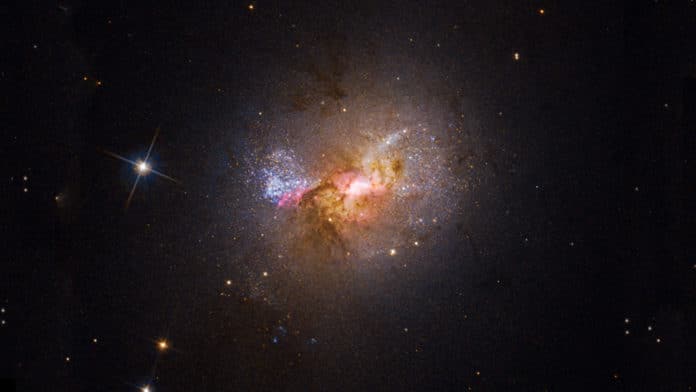Hubble offers a clearer view of the connection between the black hole and a star formation in the dwarf galaxy Henize 2-10. The dwarf galaxy lies 30 million light-years away, in the southern constellation Pyxis.
A black hole is known for sucking the material inside it. But, this is not the same case in galaxy Henize 2-10. In the case of dwarf galaxy Henize 2-10, the gas flowing outward the black hole contributes to the firestorm of new star formation. The black hole in Henize 2-10 is around 1 million solar masses.
Amy Reines, who published the first evidence for a black hole in the galaxy in 2011 and is the principal investigator on the new Hubble observations, said, “Ten years ago, as a graduate student thinking I would spend my career on star formation, I looked at the data from Henize 2-10, and everything changed. From the beginning, I knew something unusual and special was happening in Henize 2-10, and now Hubble has provided an obvious picture of the connection between the black hole and a neighboring star-forming region located 230 light-years from the black hole.”
“That connection is an outflow of gas stretching across space like an umbilical cord to a bright stellar nursery.”
Hubble spectroscopy shows the outflow was moving about 1 million miles per hour. Newborn star clusters determine the path of outflow, Hubble also calculates their age.
Reines said, “Hubble’s amazing resolution clearly shows a corkscrew-like pattern in the velocities of the gas, which we can fit the model of a precessing, or wobbling, outflow from a black hole. A supernova remnant would not have that pattern, and so it is effectively our smoking-gun proof that this is a black hole.”
More research on dwarf galaxy black holes in the future could offer clues on the mystery of how supermassive black holes came to be in the early universe.
Reines said, “The era of the first black holes is not something that we have been able to see, so it has become the big question: where did they come from? Dwarf galaxies may retain some memory of the black hole seeding scenario that has otherwise been lost to time and space.”
Journal Reference:
- Schutte, Z. et al. Black-hole-triggered star formation in the dwarf galaxy Henize 2-10. Nature 601, 329–333 (2022). DOI: 10.1038/s41586-021-04215-6
